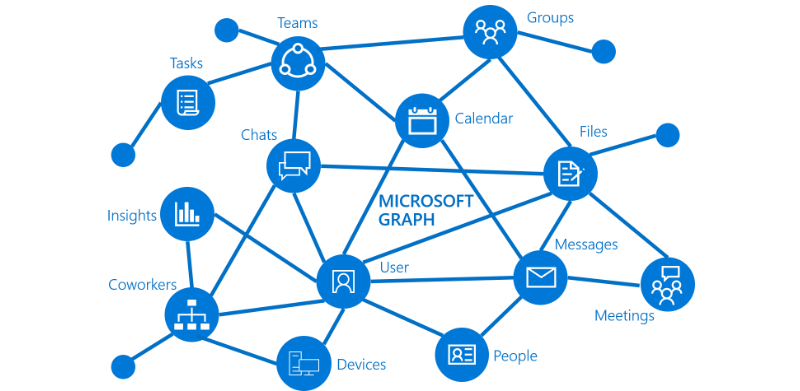Centralpoint's Data Transfer utilities are integrated with Office 365, and Azure Cloud, via Microsoft Graph. This allows for records in o365 to be indexed, ingested, and receive automated metadata from o365. This data transfer routine requires the administrator Verify their identity before running, or scheduling to run periodically. For more information, please see Data Transfer, Data Transformation, Data Mining, and Automated Metadata. Please find below information on the Microsoft Graph Integration and how it works:
What is Microsoft Graph?
Microsoft Graph exposes REST APIs and client libraries to access data on the following Microsoft cloud services:
- Microsoft 365 core services: Bookings, Calendar, Delve, Excel, Microsoft 365 compliance eDiscovery, Microsoft Search, OneDrive, OneNote, Outlook/Exchange, People (Outlook contacts), Planner, SharePoint, Teams, To Do, Workplace Analytics.
- Enterprise Mobility and Security services: Advanced Threat Analytics, Advanced Threat Protection, Azure Active Directory, Identity Manager, and Intune.
- Windows 10 services: activities, devices, notifications, Universal Print.
- Dynamics 365 Business Central.
To find out more, see Major services and features in Microsoft Graph.

What can you do with Microsoft Graph?
Use Microsoft Graph to build experiences around the user's unique context to help them be more productive. Imagine an app that...
- Looks at your next meeting and helps you prepare for it by providing profile information for attendees, including their job titles and managers, as well as information about the latest documents they're working on, and people they're collaborating with.
- Scans your calendar, and suggests the best times for the next team meeting.
- Fetches the latest sales projection chart from an Excel file in your OneDrive and lets you update the forecast in real time, all from your phone.
- Subscribes to changes in your calendar, sends you an alert when you’re spending too much time in meetings, and provides recommendations for the ones you can miss or delegate based on how relevant the attendees are to you.
- Helps you sort out personal and work information on your phone; for example, by categorizing pictures that should go to your personal OneDrive and business receipts that should go to your OneDrive for Business.
- Analyzes at-scale Microsoft 365 data so that decision makers can unlock valuable insights into time allocation and collaboration patterns that improve business productivity.
- Brings custom business data into Microsoft Graph, indexing it to make it searchable along with data from Microsoft 365 services.
Pick the first scenario about researching meeting attendees as an example. With the Microsoft Graph API, you can:
- Get the email addresses of the meeting event attendees.
- Look them up individually as a user in Azure Active Directory to get their profile information.
You can then navigate to other resources using relationships:
Microsoft Graph continues to open up the Microsoft 365 platform for developers, and always only with the appropriate permissions
Popular API requests
Check out some of these common scenarios for working with the Microsoft Graph API. The links take you to the Graph Explorer.
Bring data from an external content source to Microsoft Graph (preview)
Use Microsoft Graph connectors to bring data that is external to the Microsoft cloud into Microsoft Graph. Examples of such data can be an organization's human resources database or product catalog, hosted on-premises or in the public or private clouds.
Microsoft Graph connectors create connections to external data sources, index the data, and store it as external custom items and files. Once indexed, those items can show up in Microsoft Search, and for apps that use the Microsoft Search API.
Access Microsoft Graph data at scale using Microsoft Graph Data Connect
Use Microsoft Graph Data Connect to access data on Microsoft Graph at scale, while allowing administrators granular consent and full control over their Microsoft Graph data. Data Connect streamlines the delivery of this data to Microsoft Azure.
Using Azure tools, you can then build intelligent apps that:
- Find you the closest expert on a topic to you in your organization
- Automate knowledge base creation
- Analyze meeting requests to provide insights into conference room utilization
- Detect fraud with productivity and communication data
When should I use Microsoft Graph API or Data Connect?
Microsoft Graph Data Connect provides a new way for you to interact with the data that's available through Microsoft Graph APIs. Data Connect provides a unique set of tools that streamline the building of intelligent applications, all within the Microsoft cloud.
Centralpoint is recognized by Gartner as a Digital Experience Platform. Centralpoint offers the most robust module gallery out of the box, including integration with Active Directory, SAML, and supports Multichannel websites, Data Transfer, Data Mining, Automated Retention Policy Management, and Dynamic Document Assembly. Centralpoint is updated bi-weekly, via a pull update whether on premise or installed in the cloud guaranteeing all users stay up to date with the best digital tools available in the market.